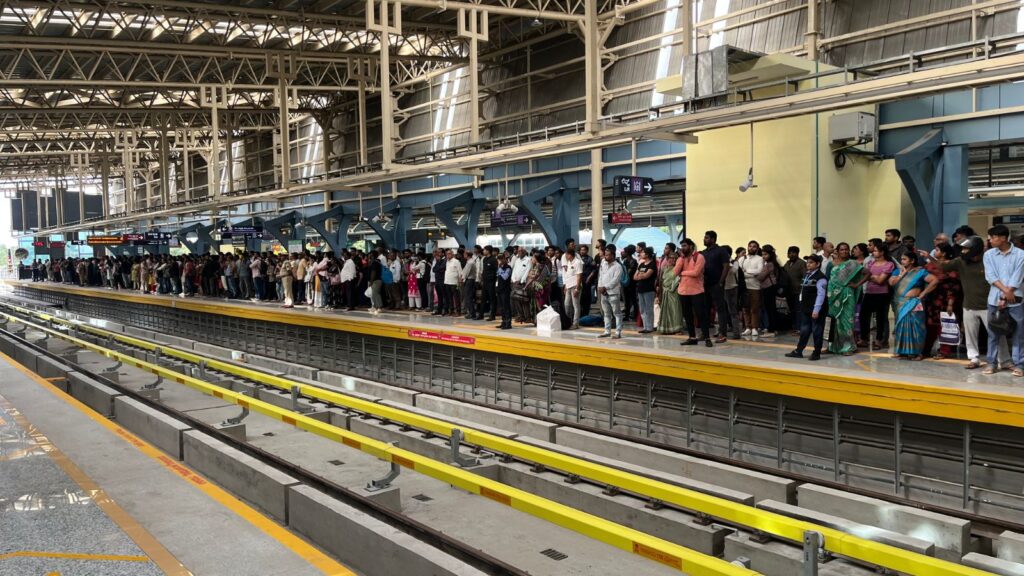Bengaluru Metro Rail Corporation Limited (BMRCL) hit a record ridership of 10.48 lakh during its first day of services Monday, a day after Prime Minister Narendra Modi inaugurated the 19.15 km Yellow Line between R V Road and Bommasandra.
According to data shared by BMRCL, the Purple Line recorded 4.5 lakh riders, the Green Line recorded 2.9 lakh, and the newly inaugurated Yellow Line saw 52,215 riders.
Both the interchange stations — Majestic and R V Road — saw a ridership of 2.5 lakh, amounting to 10.48 lakh. R V Road Metro Station now serves as the second interchange station connecting the Green Line (North-South corridor) and the Yellow Line. Until Sunday, on average, BMRCL used to record a ridership of around 8 lakh.
BMRCL is currently operating only three trains at a frequency of 25 minutes between the 19 km stretch connecting R V Road and Bommasandra.
‘It gets tricky on the Yellow Line’
While the opening of the much-awaited Yellow Line has brought cheers among commuters, concerns remain over overcrowding at R V Road Metro Station.
With trains running at a frequency of 25 minutes on the Yellow Line, there has been a significant surge of passengers at the R V Road station, which is also servicing the North-South corridor connecting Madavara and Silk Institute. This is primarily due to a lack of coach availability, rendering BMRCL very little bandwidth to operate trains at a higher frequency.
Dr Sai Prasad, dean and professor at a private university on Hosur Road, told indianexpress.com, “The Yellow Line did bring relief from traffic, especially along Silk Board junction, Bommanahalli, and surrounding areas. However, it is a hassle with overcrowding at the R V Road Metro Station, and also inside the train”.
Story continues below this ad
“The lack of coaches and fewer frequency intervals has caused crowding at the R V Road Metro Station platforms with hundreds of passengers. Ideally, some operational change could have been explored as such, servicing stations only where footfalls are higher,” added Prasad.
“As we arrived at R V Road, it looked like the entire Yellow Line crowd moved to the Green Line platform towards Majestic, and it got super crowded. It got cleared as soon as the Green Line train arrived, but on the Yellow Line, it gets tricky as the wait is longer and the crowd keeps increasing,” said Shilpa Rao, a regular metro commuter.
Satya Arikutharam, an urban mobility expert, said, “The stations, especially the R V Road interchange, are operating at their seams. Four years later, with just one fourth of trains operating, crowding must have been foreseen by BMRCL. Even small operating perturbations can give rise to a dangerous safety situation. BMRCL must resort to a stricter crowd management protocol, which I am afraid might also include limiting the number of passengers on the platforms.”
A BMRCL spokesperson told indianexpress.com, “We are studying the ridership patterns and analysing them. There is overcrowding at the R V Road Metro Station. We will deploy extra security personnel to manage the crowd better. We will install additional barriers and deploy security measures to manage the transit at the interchange station. We cannot introduce any operational changes like servicing only a few stations because it would cause inconvenience to passengers.”
Story continues below this ad
“One of six car sets arrived Monday night. Once we assemble these coaches into a six-car train set, it has to undergo at least 15-20 days of tests and trial runs before commissioning it for service. The trial runs will take time because we have to run them during the non-revenue hours,” the spokesperson added.
‘Getting this right isn’t rocket science’
Meanwhile, Bengaluru South MP Tejasvi Surya alleged that commuters are already facing confusion due to a mismatch in the names of the stations in the Electronic City area.
In a post on social media Tuesday, Surya termed the issue “a textbook case” of why the proposed Bengaluru Metropolitan Land Transport Authority (BMLTA) is necessary to ensure coordination among the city’s various transport agencies.
The controversy centres on two stations — Electronic City and Konappana Agrahara. According to Surya, the station physically located in the Electronic City area has been named Konappana Agrahara, while the one in Konappana Agrahara has been named Electronic City.
Story continues below this ad
“If you buy a ticket to ‘Konappana Agrahara’, you’ll get off at Electronic City. You would have crossed your intended station one stop before, and will also be fined for the same,” he said, pointing out that the mismatch could lead to commuter inconvenience and penalties.
The BJP leader noted that while Bengaluru Metropolitan Transport Corporation (BMTC) uses the correct geographic names for its bus stops — calling Electronic City Electronic City and Konappana Agrahara Konappana Agrahara — this creates an additional layer of confusion for passengers switching between the Metro and buses, as they must “mentally swap” the names when changing modes of transport.
“Getting this right isn’t rocket science, it’s basic coordination,” Surya remarked, urging the Bangalore Metro Rail Corporation Limited (BMRCL) to “fix the naming mess immediately”.
He also called on Deputy Chief Minister D K Shivakumar to expedite the constitution of BMLTA to prevent such lapses in future.

